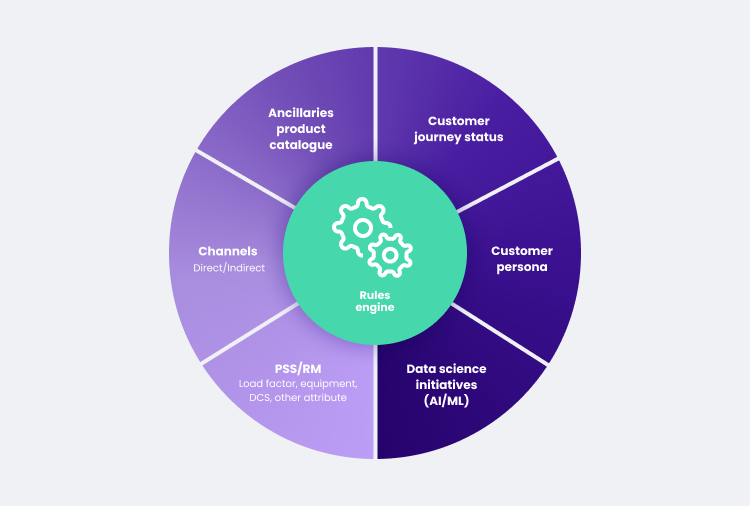During the pandemic, when air passenger traffic was at an all-time low, a few smart airlines demonstrated record-breaking sales by earning even more than 50% of their revenue from their ancillary products and services. Indeed, ancillary sales revenue is no longer seen as an airline’s secondary option. Instead, it has now taken a front seat in the airline business model.
In this context, we need to note that the traditional way of retailing does not cater to today’s tech-savvy customer who is information-rich but time-poor. In the current era of disruptive technological changes and a highly commoditized travel world, airlines have a cut-throat competition where products and services that may be cutting edge today can become outdated soon.
Adopting the advanced retailing concept in the airline industry is going to be one of the biggest transformations in the industry.
Customer loyalty is not what it used to be. With increased transparency on comparative prices and easier access to booking tools, travelers are increasingly loyal to those that provide the best prices and experiences. These fluctuating trends and rising consumer expectations make it challenging for airlines to keep up with the changing times.
The USP in this competition is the outstanding customer experience that revolves around a customer-centric approach. This allows an airline to deliver a positive and personalized experience at every stage of its customer journey. They can interact with customers based on their needs, adopt a fact-based approach to decisions using customer data as a primary source of insight, and embrace new channels to build a customer-focused culture, creating value across the way.
Many forward-thinking airlines have already embarked on adopting smart merchandising strategies to deliver a tailored, personalized, and seamless experience to individual travelers.
 Smart merchandising strategies driven by an AI-based retail rule engine
Smart merchandising strategies driven by an AI-based retail rule engine
In this blog, we will attempt to explore various best practices, frameworks, strategies, and techniques for an airline to deploy a successful merchandising strategy. This strategy will deliver exceptional customer experiences along with higher conversion rates.
The mantra behind successful merchandising revolves around five key areas, and they are:
- Identify the right personas for your travelers
- Contextualize your offer in real-time
- Deploying the best packaging techniques
- Target the right time and stage of the journey
- Deliver a seamless digital experience
1. Define the right persona for your travelers
An airline caters to millions of passengers in a year. Every customer has unique needs and has a different perception of products and service values. If you understand those differences and are flexible in how you offer the services they need, you can gain a competitive advantage.
Customer segmentation is a strategy to divide customers into various groups or personas having similar characteristics, wants, and needs.
Traditionally, airlines used to segment customers based on the booking class, which today holds limited relevance and doesn’t reflect complex passenger behavior. To overcome this challenge, airlines can leverage technologies like artificial intelligence and machine learning to develop self-learning models which analyze the below-listed factors and self-calibrate to optimize the personas.
- Geographical: Country, state, climate, food habits, etc.
- Demographic: Age, gender, marital status, family size, nationality, ethnicity
- Behavioral: Spending pattern, price sensitivity, need for flexibility, loyalty index, CLI
- Psychographic: Personality traits, activities, interest
At the same time, each persona defined by the airline must be:
- Measurable: In terms of volume, purchasing power, and other characteristics, an airline can predict as well as target the revenue and profit a segment can make.
- Accessible: The persona is easily accessible so that the airline can approach them.
- Differentiable: Each persona must be unique and reacts differently to the market mix.
- Actionable: Airlines be able to provide value to the segment.
A good segmentation strategy should have a persona for each passenger category and reveal underserved segments. For example, an airline receives most of its bookings from guest users, and the airline does not possess any historical data individually for these customers. But, by using engaging factors like demographical and geographical, airlines can achieve segmentation. In a recent survey conducted with an airline, it was discovered that young travelers between the age of 18-35 going from Oslo to Switzerland during winter had shown an affinity towards XL baggage for carrying their skiing kits. So, using such insights, airlines can target customers with similar personas to elevate sales.
2. Contextualize your offer in real-time
Now that we know each traveler’s persona has specific needs, the second step is to set the right context so that the customer understands the value that a recommended ancillary is going to deliver. For example, a business executive taking an early morning flight from an airport that experiences a high passenger load around the time of departure can open an opportunity to sell fast-track ancillary.
Contextualizing helps the traveler understand the benefits of the offer then and there.
Airlines can tap into such opportunities by leveraging an intelligent merchandising engine. These build a knowledge graph for each persona to understand their affinities towards ancillaries. They then evaluate it with real-time contexts like load factors, routes, flight duration, and peak hours through a robust scoring algorithm for ancillary recommendation across various stages of the travel lifecycle. Doing so significantly improves the likelihood of making a purchase hence, delivering a higher conversion rate.
3. Deploy the best packaging techniques
Airlines use various offer creation and packaging techniques like bundled ancillaries, unbundled ancillaries, and hybrid bundling (branded fares) to personalize an offer. Each of these techniques plays a role when targeted to the right customer. Branded fares or bundled ancillaries deliver a simple approach to building an all-inclusive fare, reducing the complexity of choice and making comparison and purchase decisions easier for passengers. But at the same time, with evolving customer expectations, it is a huge challenge for an airline to decide which ancillary items to bundle and which items to offer separately.
The best-fit package results in value to the customer and higher per-passenger revenue for the airline.
Deploying an intelligent merchandising engine that can generate multidimensional insights on ancillary sales performance across all channels and travel lifecycles can help revenue managers optimize their packaging techniques or even take a step ahead to tailor the bundles in real-time for a customer.
4. Target the right time and stage of the journey
Airlines can maximize their ancillary sales by encouraging customers at various stages of their travel lifecycle, beginning from the inspiration that starts the planning in the first place, all the way through the booking process, to pre-and post-trip engagement. Each stage offers a unique upsell or cross-sell opportunity that a traveler may consider.
The most important thing that airlines need to keep in mind here is to offer the customer the right product at the right time.
Not everything can be sold during the booking; travelers develop their needs as they proceed. Airlines can use their data to understand customers’ specific needs to determine the behavioral factors, purchasing patterns, and affinity factors for each persona.
The choice of the product can be determined by the customer persona and contextualization. In contrast, the stage of the journey should be targeted, considering when it will be needed the most. On the other hand, the choice of the channel can be determined by the accessibility factors, and the price should prove to be a good value to the customer – it should neither be too high nor too less.
For instance, a family of four going for a week-long summer vacation would be interested in booking a hotel room at the time of flight booking. A few days before departure, when they start packing, they might opt for extra luggage and finally may need a taxi on the day of departure. Whereas a backpacker who is a price-sensitive traveler may look for a cozy hostel room at the time of booking and may be interested in some good adventure deals as per destination.
5. Deliver a seamless digital experience
Delivering a one-click buying experience that enables customers to make informed purchases can be a differentiator among competitors. Along with the perfect offer, an airline should focus on the user experience they deliver to the customer.
The user experience should be fast, easy, and intuitive so that a customer can easily navigate to buy and manage their purchases.
An average user experience can easily make customers disinterested, even if they see a good offer. On the other hand, a good user experience delivers high-quality content and information about a product, which in turn converts lookers into bookers.
Airlines need to understand the challenges associated with different distribution channels, primarily indirect and direct.
- Indirect channels
From a customer perspective, shopping through an indirect channel provides a disjointed user experience where they are not presented with personalized offers and don’t have access to the products they could purchase from an airline. From the airline’s perspective, they have to manage multiple EMDs for the ancillary purchase per ticket while distributing via a GDS channel.
- Direct channels
To overcome these challenges, digitally matured airlines have adopted IATA standards such as New Distribution Capability (NDC) and ONE Order to modernize their product retailing and create a transparent shopping experience. NDC allows airlines to easily sell ancillary along with rich content directly to aggregators like OTA and GDS via a set of standard XML APIs (which was not possible earlier) and get away with the challenges of EMD issuance for ancillary purchases.
The capabilities of NDC clubbed with AI models can help airlines build a smart & advanced retailing system that offers customers a better product and more value. NDC enables airlines to sell flights and ancillaries the retail way, and AI-based technologies enable the airlines to add a personalized and contextual wrapper, so you are selling the right thing and have a higher look-to-book ratio. This enables the airline to transition from non-personal selling to retail-driven personalized selling.
Conclusion
The power of digital airline retailing is no more a secret. Revenue managers have identified its real potential and are leveraging it to target more sales. As we enter the digital revolution, the right set of techniques along with technologies like AI/ ML and big data could be the first step towards deploying successful merchandising strategies towards building a great customer experience and path to profitability.
Are you ready to join the digital retailing revolution? Please reach out to explore.tnl@nagarro.com to discuss more!





